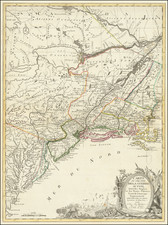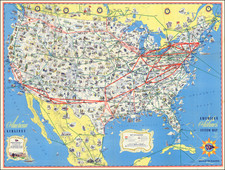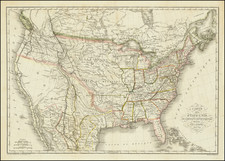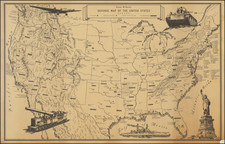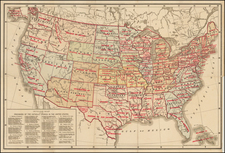Unusual and highly informative map of the US, purportedly showing the principal botanical divisions, a partly synthetic attempt to describe the flora of the country. The map was designed by Thomas C. Porter, Professor of Botany at Lafayette College and a noted Colorado Botanist.
The regions colored are the forest, Florida, prairie, cactus, Rocky Mountain, and Pacific, and these are further subdivided. Some of the divisions are vague, such as that between the Northern and Southern Province of the Pacific region, which happens to be located at exactly the California-Oregon border. However, these divisions would still be of use to the avid 18th-century reader who would begin to understand the breakdown of how the plants that grow in different regions change across the country.
The map is very fascinating and represents an far-reaching popular science work by one of the nation's leading experts on the subject.
Thomas Porter
Thomas Porter was born in Pennsylvania. He attended Lafayette College and graduated at the age of eighteen. He attended the Princeton Theological Seminary and graduated in 1844. Soon after, he took a position as minister at a Presbyterian church in Monticello, Georgia . While in north Georgia, he collected and explored Stone Mountain and Toccoa Falls . Of these collections, he sent his notes and description to Asa Gray at Harvard.
In 1848, Porter became ordained and took a position at the Second German Church in Reading, Pennsylvania. One year later, he left his ministerial duties to teach chemistry, botany, and zoology, at Marshall College in Mercersburg. While at Marshall College, Porter published his first botanical paper in 1850. The subject was a collection of plants made by T.A. Culbertson, in Missouri. He continued his teaching at Marshall College (later Franklin and Marshall College), for the next seventeen years. In 1866, he left to teach botany and zoology at Lafayette College, where he remained until 1897. In addition to teaching, he served as pastor of the Third Street Reformed Church in Easton.
Porter made his first visit to Colorado in 1869. For five years he explored and collected in the central Rocky Mountains. During these trips, he and his field crew accompanied F.V. Hayden of the U.S. Geological and Geographical Survey of the Territories. As a result of these collections and valuable help from J.M. Coulter, Parry, and others, Porter and Coulter wrote the Synopsis of the Flora of Colorado, the first flora of Colorado, in 1874. This book firmly established the range of many plant species throughout the Rocky Mountains. Newly discovered species described by Porter in Synopsis, include Erigeron coulteri, Erigeron glandulosum, Astralagus brandegei, Astralagus scopulorum, and Penstemon brandegei.
Many of Porter's personal collections were from the area of Greeley, Colorado City, the canyons of the Front Range, and Denver, including Gilbert Meadows in the Unita Mountains. He also made excursions to South Park via Ute Pass, Twin Lakes, Monument Park, and Pikes Peak. Among his collections, Porter collected the type specimen of Melica porteri, at Glen Eyrie. Other species first described by Porter now bear his name: Aster porteri (re-named in honor of Porter by Asa Gray), Calamagrostis porteri, and Muhlenbergia porteri. Most of Porter's collections are housed at the Porter Herbarium of the Academy of Natural Sciences in Philadelphia.
O. W. Gray was a publishing firm based in Philadelphia. Later, they published as O. W. Gray & Son. They published atlases in the late nineteenth century. Gray's National Atlas was one of the most successful commercial ventures of the 1870s and one of the last to employ hand coloring on maps.









